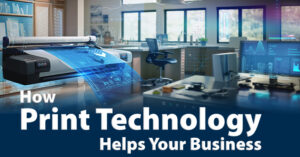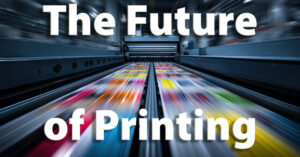Category Archives: Workflow Automation
In today’s hyper-connected world, cybersecurity is a top priority for any organization. We invest in firewalls, secure our networks, and train employees to spot phishing attacks. But what if one of the biggest security risks is hiding in plain sight? Modern multifunction printers (MFPs) are no longer simple office equipment; they are sophisticated, network-connected computers that handle a constant flow of sensitive data. And just like any other endpoint, they are a prime target for cybercriminals.
Recent data shows that a staggering 94% of small to medium-sized businesses (SMBs) have experienced at least one cyberattack [1], with a growing number of these incidents traced back to overlooked devices like printers. The average cost of a data breach in 2025 has reached $4.4 million globally [2], a clear indicator that no business can afford to ignore any potential vulnerability. This post will explore the evolving landscape of printer security threats, the real-world costs of a breach, and the actionable steps you can take to protect your organization.
Why Are Printers a Top Security Risk in 2025?
Printers have become the silent vulnerability in many organizations’ cybersecurity posture. A recent report from HP Wolf Security highlights a critical disconnect: while IT teams spend an average of 3.5 hours per printer each month on security, significant gaps remain [3]. The research, which surveyed over 800 IT and security decision-makers, revealed that only 36% of IT teams apply printer firmware updates promptly [3]. This failure to patch creates a massive window of opportunity for attackers to exploit known vulnerabilities.
The problem begins at the procurement stage. According to the same report, a concerning 60% of IT leaders admit that a lack of collaboration between procurement, IT, and security teams puts their organization at risk [3]. This often results in devices being added to the network without proper security vetting, leaving them exposed from day one.
Here’s a summary of the key risk areas identified in the report:
| Lifecycle Stage | Key Statistic | Implication |
| Supplier Selection | Only 38% of organizations have collaborative security standard definitions 3. |
Insecure devices are purchased and onboarded. |
| Ongoing Management | Only 36% of IT teams apply firmware updates promptly 3. | Known vulnerabilities remain unpatched for extended periods. |
| Remediation | Only 32% can detect hardware-level security events 3. | Active breaches on printers can go unnoticed. |
| Decommissioning | 86% cite data security as a barrier to printer reuse or recycling 3. | Sensitive data is not properly sanitized from end-of-life devices. |
The High Cost of Neglect: Financial and Compliance Risks
The financial repercussions of a data breach can be devastating. As mentioned, the global average cost of a data breach in 2025 is $4.4 million [2]. For small and medium-sized businesses, which are often less equipped to handle such a blow, the consequences can be even more severe. Cybercriminals specifically target SMBs because they are more likely to pay a ransom to avoid extended downtime and the associated revenue loss [1].
Beyond the immediate financial costs, there are also significant compliance risks. Many industries are subject to strict data protection regulations, and a printer-related breach can lead to hefty fines and legal action. Here are a few examples of how printer security intersects with major compliance frameworks:
- GDPR (General Data Protection Regulation): Any organization handling the data of EU citizens must ensure that all data processing activities, including printing, are secure. A breach of personal data via an unsecured printer can result in fines of up to €20 million or 4% of the company’s annual global turnover, whichever is higher.
- HIPAA (Health Insurance Portability and Accountability Act): In the healthcare sector, printers and MFPs are constantly handling Protected Health Information (PHI). A breach of PHI through an unsecured device is a direct violation of HIPAA, which can lead to significant fines and reputational damage.
- PCI DSS (Payment Card Industry Data Security Standard): For businesses that handle credit card information, any system that stores, processes, or transmits cardholder data is in scope for PCI DSS. If a printer is on the same network as a point-of-sale system and is not properly segmented, it could be used as a pivot point for an attack, putting the organization out of compliance.
Failing to secure your print environment is not just a technical oversight; it’s a significant business risk with far-reaching financial and legal consequences.
How to Build a Secure Print Environment: An Actionable Framework
Securing your print infrastructure doesn’t have to be an overwhelming task. By adopting a proactive and strategic approach, you can significantly reduce your risk profile. Here are the essential steps every organization should take to build a resilient print environment:
- Treat Printers as Endpoints, Not Appliances: The single most important shift is to treat your printers with the same level of security scrutiny as your servers and workstations. This means including them in your regular vulnerability scanning, patch management, and security monitoring processes. As the data shows, with only 36% of IT teams applying firmware updates promptly, this is a critical area for improvement [3].
2. Implement a Zero-Trust Approach: In a modern, decentralized network, no device should be trusted by default. Implement user authentication on all printers to ensure that only authorized employees can access them. Secure pull printing, where jobs are held in a queue until the user authenticates at the device, is an effective way to prevent sensitive documents from being left unattended.
3. Encrypt Data at Rest and in Transit: Any data stored on a printer’s internal hard drive should be encrypted. This includes cached documents, user credentials, and device settings. Similarly, all data transmitted to and from the printer over the network should be encrypted to prevent eavesdropping.
4. Segment Your Network: Isolate your printers on a separate VLAN (Virtual Local Area Network). This simple step can have a major impact on your security. If a printer is compromised, network segmentation limits the attacker’s ability to move laterally across your network and access other critical systems.
5. Establish a Secure Decommissioning Process: As the HP Wolf Security report revealed, 86% of organizations see data security as a barrier to printer reuse or recycling [3]. It is crucial to have a formal process for sanitizing data from end-of-life devices. This may involve using the printer’s built-in secure erase functions or, in some cases, physically destroying the storage media.
How Repro Products Can Help You Build a Resilient Print Environment
At Repro Products we understand that securing your print infrastructure is a critical component of your overall cybersecurity strategy. We specialize in providing secure print technology and managed print services that are designed to protect your organization from the evolving threat landscape. Our team of experts can help you:
- Assess Your Current Vulnerabilities: We conduct comprehensive security assessments to identify and prioritize risks in your current print environment.
- Implement a Zero-Trust Framework: We help you deploy secure print release, user authentication, and document encryption to ensure that your data is always protected.
- Automate Your Security Operations: We provide automated firmware updates, network monitoring, and threat detection to keep your devices secure and compliant.
- Ensure Regulatory Compliance: We help you navigate the complex landscape of data protection regulations, including GDPR, HIPAA, and PCI DSS, to ensure that your print environment meets all necessary compliance requirements.
Don’t Let Your Printers Be Your Downfall
The evidence is clear: printers are no longer a peripheral concern in cybersecurity. They are a primary target for attackers, and a single unsecured device can lead to a devastating data breach. By taking a proactive and strategic approach to printer security, you can protect your organization from financial loss, reputational damage, and regulatory penalties. The time to act is now.
Ready to secure the last gap in your cybersecurity perimeter? Request a complimentary print security assessment today and discover how we can help you build a more resilient and secure print environment.
GET STARTED
References
[1] ConnectWise, “The State of SMB Cybersecurity in 2024,” cited in Sharp, “Why SMBs Are Prime Targets for Printer-Related Cyberattacks in 2025,” January 22, 2025. https://business.sharpusa.com/simply-smarter-blog/why-smbs-are-prime-targets-for-printer-related-cyberattacks-in-2025
[2] IBM, “Cost of a Data Breach Report 2025,” 2025. https://www.ibm.com/reports/data-breach
[3] HP Wolf Security, “Securing the Print Estate: A Proactive Lifecycle Approach to Cyber Resilience,” July 17, 2025. https://www.hp.com/us-en/newsroom/press-releases/2025/only-36-of-it-teams-apply-printer-firmware-updates-promptly-leaving-devices-vulnerable.html
Category Archives: Workflow Automation
Print technology—including copiers, multifunction printers, wide-format printers, scanning services, production printing, and proactive servicing—helps businesses prepare for year-end by:
- Simplifying reporting and compliance with secure scanning and document management.
- Reducing waste and optimizing print resources before budget resets.
- Supporting hybrid teams with cloud-connected printers and secure remote access.
- Preventing downtime during the Q4 crunch through preventive maintenance.
Why Print Technology Matters at Year-End
For many organizations, the final quarter is a pressure point: year-end reports, compliance audits, budget resets, and project deadlines converge. Print technology plays a pivotal role in streamlining workflows that keep teams compliant, connected, and productive.
When integrated strategically, your print environment does more than output paper—it becomes a document hub, a compliance tool, and a collaboration enabler.
1.) Year-End Reporting and Compliance
Challenge: Many industries—from finance to healthcare—must close out the fiscal year with meticulous documentation. Paper records, scanned invoices, and compliance forms pile up quickly.
How Print Tech Helps:
– Secure Scanning: Multifunction printers (MFPs) convert paper into encrypted digital files that integrate with document management systems.
– Audit-Ready Storage: Cloud document management ensures files are indexed, searchable, and ready for retrieval.
– Regulatory Alignment: Features like password-protected printing and audit trails support compliance with HIPAA, SOX, and GDPR.
2. Reducing Print Waste Before Budget Resets
Challenge: Departments often face “use-it-or-lose-it” budget cycles, leading to wasteful end-of-year spending.
How Print Tech Helps:
– Usage Analytics: Print management software tracks output and highlights waste.
– Rules-Based Printing: Enforce duplex (double-sided) printing or grayscale defaults.
– Sustainability Wins: Reduced waste also supports corporate ESG initiatives.
Visual Idea: Bar chart showing “Average Department Print Costs” before vs. after optimization.
3. Supporting Hybrid and Remote Teams
Challenge: End-of-year work often requires teams across locations and time zones to collaborate on the same documents.
How Print Tech Helps:
– Cloud-Connected Printers: Employees can securely release print jobs from anywhere.
– Mobile Printing: Teams working remotely can submit jobs via smartphone or tablet.
– Secure Document Sharing: Cloud services ensure consistent access without sacrificing security.
4. Preventive Servicing for Q4 Reliability
Challenge: The year’s busiest quarter is the worst time for printers or production equipment to fail.
How Print Tech Helps:
– Scheduled Maintenance: Reduces risk of breakdowns during high-volume periods.
– Predictive Monitoring: Alerts teams before a problem disrupts workflows.
– Service Contracts: Keep toner, parts, and support ready for crunch time.
Don’t let year-end bottlenecks slow your business. Our print experts can help you streamline workflows, reduce waste, and stay audit-ready before Q4 deadlines hit.
BOOK A YEAR-END WORK FLOW ASSESSMENT
Category Archives: Workflow Automation
In today’s fast-moving digital workplace, one of the most impactful trends reshaping the way organizations manage documents is the integration of printers with business platforms. Far from being stand-alone devices, modern printers—including copiers, wide-format printers, and multifunction printers—are now seamlessly connecting with platforms such as Google Workspace, Microsoft 365, and industry-specific solutions.
This shift is more than a convenience; it’s a transformation. Businesses are reducing costs, boosting efficiency, enhancing security, and empowering their teams to work smarter. For IT professionals and decision-makers, understanding this integration trend is critical for staying competitive in 2025 and beyond.
At [Your Company Name], we’ve been “building results for the people we serve since 1979,” and we see printer-to-platform integration as one of the most powerful developments for organizations looking to optimize workflows and safeguard data. Below, we explore the key benefits of this trend and provide examples across industries.
Cloud Connectivity and Remote Access
The pandemic accelerated remote and hybrid work, and businesses have not looked back. Printers that integrate directly with cloud platforms are no longer optional—they’re essential.
With Google Workspace or Microsoft 365 integration, employees can print, scan, and share documents from anywhere using secure cloud services. No need for on-premises print servers or complicated VPN setups. Small businesses, in particular, gain from centralized cloud-based printing that simplifies operations and reduces IT costs.
Example in education: Teachers can scan and upload assignments directly to cloud folders, where students can access them instantly. Likewise, students can print or submit work without ever touching a USB drive or emailing files back and forth. The process is streamlined, secure, and efficient.
When paired with devices like the Xerox AltaLink, which is purpose-built for cloud integration, businesses gain the flexibility to securely connect workflows from the classroom to the boardroom.
Workflow Automation and Customization
Integration is not just about connecting to the cloud—it’s about automating repetitive processes to save valuable time.
Modern multifunction printers (MFPs) can be configured to automatically route scanned documents into the correct document management systems or cloud folders. For example:
- Healthcare: Forms scanned at the reception desk can be automatically uploaded into the correct patient’s electronic health record (EHR). This eliminates manual uploads and reduces the risk of misplaced files.
- Finance: Monthly reports can be auto-sorted, named, and routed into secure folders for auditing, saving hours of repetitive work for staff.
- Construction & Architecture: Wide-format printers can integrate with project management platforms, automatically syncing large blueprints and revisions for team access.
The Xerox AltaLink exemplifies this capability with its ConnectKey® Technology, which allows organizations to customize workflows to their specific business needs. Whether it’s setting up one-touch shortcuts or linking directly to industry-specific applications, automation helps teams spend less time managing documents and more time delivering value.
Security and Compliance
As document workflows move to the cloud, security becomes paramount. The good news: printers that integrate deeply with business platforms bring enterprise-grade safeguards.
For instance, secure print release ensures that sensitive documents only print when the authorized user is physically at the device. Transfers between the printer and cloud storage are encrypted end-to-end, preventing data leaks. User authentication, often tied to Microsoft Azure Active Directory or Google accounts, ensures compliance with company policies and regulatory requirements.
Industries like healthcare, finance, and education—where data protection is non-negotiable—stand to benefit the most:
- Healthcare: HIPAA compliance is supported by encrypted transmissions and user-level access control.
- Education: FERPA requirements are upheld by restricting who can access or release student documents.
- Finance: Secure workflows ensure compliance with audit trails and financial regulations.
By choosing a device like the Xerox AltaLink, businesses can confidently handle sensitive information, knowing their technology is designed with compliance in mind.
User Experience Enhancements
Beyond efficiency and security, user experience is driving adoption. Today’s printers don’t just integrate—they interact with users in intuitive, user-friendly ways.
- Single Sign-On (SSO): Employees log in once using their Microsoft 365 or Google credentials and gain seamless access to print, scan, and cloud folders.
- Mobile Printing: From smartphones and tablets, users can print directly from cloud apps without installing complex drivers.
- Voice Commands & Smart Interfaces: Some devices now respond to voice assistants, allowing users to command a print job hands-free. Touchscreen interfaces are designed to mirror smartphone simplicity, making navigation second nature.
The result? Less training, fewer IT help desk calls, and more productivity. Printers no longer feel like clunky hardware; they operate like the rest of the modern digital ecosystem.
Industry-Specific Applications
To appreciate the full impact of printer-platform integration, it helps to see it in action across industries:
- Automotive Sales: Teams can print contracts or sales brochures directly from the CRM system. No more exporting and emailing files—just one seamless connection between CRM and MFP.
- Education: Teachers upload assignments to cloud folders; students retrieve and print them on demand. Integration ensures efficiency while maintaining FERPA compliance.
- Healthcare: Clinics digitize intake forms directly into EHR systems, reducing errors and ensuring immediate availability for providers.
- Architecture, Engineering & Construction (AEC): Wide-format printers integrate with project management platforms, ensuring blueprints are updated in real time for all stakeholders.
These are just a few ways integration is transforming day-to-day operations. And as platforms evolve, the potential for deeper, smarter workflows will only grow.
Why This Matters for Businesses in 2025
In 2025, businesses that fail to modernize their print environments risk falling behind. Document workflows remain central to every industry, and inefficiencies in this area can significantly impact productivity, costs, and compliance.
By investing in devices like the Xerox AltaLink, organizations position themselves to:
- Simplify document workflows with direct cloud connectivity.
- Reduce IT overhead by automating processes.
- Strengthen data security and regulatory compliance.
- Deliver better employee experiences with intuitive, integrated tools.
These outcomes are not just operational wins—they directly impact customer service, employee satisfaction, and the bottom line.
Conclusion: Building Smarter Workflows Together
As we move further into 2025, the integration of printers with business platforms is no longer a “nice to have”—it’s a competitive advantage. From cloud connectivity to workflow automation, from compliance safeguards to user-friendly interfaces, businesses are reaping the rewards of devices that connect seamlessly with their digital ecosystems.
At Repro Products we’ve been “building results for the people we serve since 1979.” Our commitment to innovation and client success drives us to offer solutions like the Xerox AltaLink, which exemplifies the future of intelligent printing.
Whether you’re a small business looking to streamline your print environment or an enterprise balancing compliance, collaboration, and efficiency, the time to explore printer integration is now.



